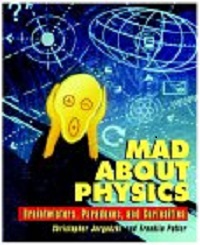Physics:Mad About Physics
 Mad about Physics cover (1st Ed.) | |
| Author | Christopher Jargodzki & Franklin Potter |
|---|---|
| Illustrator | Tina Cash-Walsh |
| Cover artist | Wendy Mount & André Craeyveldt |
| Country | United States |
| Language | English |
| Subject | Physics |
| Publisher | John Wiley and Sons |
| Media type | |
| Pages | 320 |
| ISBN | ISBN:978-0471569619 |
Mad about Physics: Brainteasers, Paradoxes, and Curiosities by Christopher Jargodzki and Franklin Potter (2001, published by John Wiley and Sons) is a book containing 397 puzzles and their solutions. The book covers information on mechanics, electricity, magnetism, and optics, as well as the physics of sports, space exploration, and astronomy. Mad about Physics has been translated into seven languages, including German, Greek, Japanese, and Chinese. As of 2013, Mad about Physics is in its 10th reprinting.
Content
From the preface: "Solutions and more than three hundred references are provided. They constitute about two-thirds of the book. Most of the puzzles contain an element of surprise. Indeed, the clash between common sense conjecture and physical reasoning is the central theme that runs through this volume. Einstein characterized common sense as the collection of prejudices acquired by age eighteen, and we agree: At least in science, common sense is to be refined and often transcended rather than venerated. The present volume tries to undermine physical preconceptions employing paradoxes (from the Greek para and doxes, meaning 'beyond belief') to create cognitive dissonance. 'Though this be madness, yet there is method in't.' We believe that far from being merely amusing, paradoxes are uniquely effective in addressing specific deficiencies in understanding. (cf. Daniel W. Welch, 'Using paradoxes.' American Journal of Physics 48 [1980]: 629–632)."
Mad about Physics cover (1st Ed.) contains a multitude of questions which are claimed to be both creative and difficult. A few examples:
- Why do professional race car drivers accelerate when going around a curve?
- Why is there eight times more ice in Antarctica than in the Arctic?
- Why is a full moon about nine times brighter than a half-moon even though its lit area is only twice as large?
- Why can you warm your hands by blowing gently and cool your hands by blowing hard?
- Why are the tallest mountains on Mars much taller than ours even though Mars is only about half the size of Earth?
An extensive set of marginalia is provided, including jokes, anecdotes, offbeat scientific facts, and unusual quotations ranging from Einstein on the sensation of the mystical to Bugs Bunny on the law of gravity. For example:
- Isaac Newton spent years trying to date the world's end. He leaned toward 1948.
- An inscription on the wall of a restroom at Princeton University: 2 + 2 = 5 for large values of 2.
- The first prize offered for communication with extraterrestrials was announced in 1900, but Mars was excluded because it was felt that contact with the Martians would be too easy.
A detailed 7-page index is also included.
Reception and Reviews
A number of reviews discuss Mad about Physics.[1][2][3]
Physicist Peter Ford (University of Bath, UK) described Mad about Physics as a "fascinating new book." He wrote that "many of its problems will be useful for teachers, both at senior level in schools and at universities, for discussion with students in small groups. Such tutorials should be used to encourage students to start talking about physics and 'thinking like a physicist.' " [4]
Carol Ryback wrote, "Here's a quick fix for those brain-teasing inquiries that stick in your mind like an old song. While not limited to astronomy-related trivia, 'Mad about Physics' – like a top-40 countdown on the radio – has an allure that makes you want more."[5]
Awards
In 2002, Mad about Physics was selected by the New York Public Library as one of the best titles of the year 2001 in the teen books and media category.[1]
See also
References
- ↑ Hubisz, John L.; Book Review (April 2003). "A Fun Way to Figure Physics: Mad about Physics: Braintwisters, Paradoxes, and Curiosities, by Christopher P. Jargodzki and Franklin Potter". The Physics Teacher (American Association of Physics Teachers) 41 (4): 256. doi:10.1119/1.1564781. Bibcode: 2003PhTea..41..256H. http://tpt.aapt.org/resource/1/phteah/v41/i4/p256_s1?isAuthorized=no=Search. Retrieved July 26, 2013.
- ↑ Boyd, James N. "Mad about Physics: Braintwisters, Paradoxes, and Curiosities." Mathematics Teacher 94.7 (2001): 614. Academic OneFile. Accessdate: July 26, 2013
- ↑ Pitt, David. "Mad about Physics: Braintwisters, Paradoxes, and Curiosities." Booklist November 15, 2000: 595. Academic OneFile. Accessdate: July 26, 2013. Full text article available – on public library Gale databases.
- ↑ Ford, Peter (July 2001). "Burst Bangers and Brain Busters". Physics World. http://physicsworld.com/cws/article/print/2001/jul/04/burst-bangers-and-brain-busters. Retrieved July 16, 2013.
- ↑ Ryback, Carol (April 2001). "Mad About Physics (Book Review)". Astronomy 29 (4): 92. Accessdate: July 26, 2013 Academic OneFile Full text article available here – on public library Gale databases.
External links
- New York Public Library (link to NYPL's list of best 2001 titles in teen books and media)
- Wiley and Sons, Inc. (link to Mad about Physics page)

